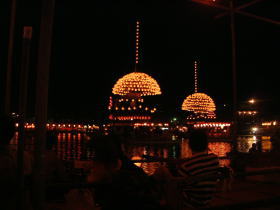 |
 |
| Makiwara-bune ( Boat with lanterns ) Saturday night |
Danjiri-bune (boat-type float with puppets wearing Noh costumes) Sunday morning |
TSUSHIMA TENNO MATSURI
4th Saturday & the following Sunday of July (fixed)
at Tenno-gawa Koen/Tenno-gawa Park
 |
 |
| Makiwara-bune ( Boat with lanterns ) Saturday night |
Danjiri-bune (boat-type float with puppets wearing Noh costumes) Sunday morning |
Tsushima Tenno Festival is one of the top three famous river festivals
in Japan.
(with TENJIN MATSURI in Osaka and KANGEN-SAI of Itsukushima Shrine in Hiroshima )
The highlight of this festival is the evening festival called Yoi-matsuri,
when five makiwara-bune¹
(boats with large strawsheaves/makiwara decorated hemisphericaly with illuminated
lanterns) are set afloat on the Tennoh river.
The glittering reflected light of lanterns on the surface of water is so
beautiful.
1) Five makiwara-bune(boats) are offered by five areas
Ex-Tsushima had five villages: Toge, Komenoza, Imaichiba, Ikadaba and Shimogamae
Mabashira has 12 (13 in leap year) lanterns which shows months in a year.
The hemisphere is shaped by 365 lanterns which shows one year though they
put approximatery 400 lanterns in reality.
At the front of boats, there are 30 lanterns called "Miyoshi-nagashi"which
shows 1 month.
Aside from these lanterns, they put several kinds of lanterns: noki-jochin,
takabari-jochin, yumihari-jochin, hako-jochin, toro, etc.
***
There are a few stories about the origin of the festival.
Some one says it's due to the story that , in the Nambokucho peroid (period
of the Northern and Southern dynasties/1336-1392),
Tsushima worriors invited worriers of Northern side go boating on the Tennoh
River and subdued them
in order to save Prince Ryoou (grand son of Emperor Godaigo/ Southern side)
who escaped to Tsushima.
Someone says that this festival was based on the shinto ritual of Tsushima
Shrine, "Miyoshi-nagashi".
But no one knows the real story about origin.
However it can be said that it's started approximately 500 years ago,
based on "Kami-mukae (welcome gods"ritual in old religion
among the people who wanted to avoid disease successfully in the equatorial
summer,
and has been grown as a popular festival.
The festival had been held on June 14th and 15th of the lunar calendar
until 1962.
But since 1963, it has been held on the fourth Saturday and the following
Sunday of July in the solar calendar.
In 1981, Tsushima Tennoh Matsuri was designated as a national intangible
folk cultual asset.
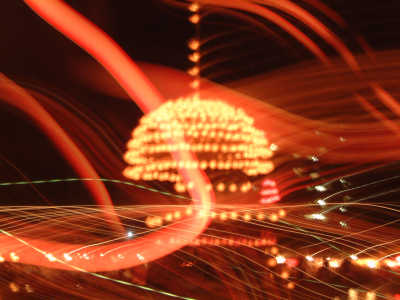 |
Yoi-matsuri is fantastic ! (Saturday night)
| schedule of main events |
|
| SATURDAY: | |
| 10:00 - | The MIKOSHI ( portable shrines ) move to Tennou-gawa Park from Tsushima Shrine |
| 18:00 - 20:30 | Events on the stage above the water: demonstration of matchlock, shamisen
( Japanese banjo ), nagauta ( a kind of Japanese traditional song ),dance, kaguradaiko ( a kind of Japanese drumming ), tedutsu-hanabi ( a kind of fireworks ), etc. |
| 19:00 - | People start lighting chouchin (Japanese lanterns ) on the 5 makiwara-bune
(boats decorated with lots of lanterns making shape of hemisphere) |
| 20:00 - | A messenger from Tsushima Shrine greets Makiwara-bune boats |
| 20:45 - | 5 boats start to sail |
| 20:50 - | Fireworks display |
| 21:30 - | 5 boats arrive at the Otabisho ( interim lodging for gods ) in Tennou-gawa Park.....................then return |
| . | . |
| SUNDAY: | |
| 8:40 - | A messenger of Tsushima Shrine greets 6 Matsuri-bune boats: 5 redecorated boats and a boat from SayaTown |
| 9:00 - | Boats start to sail |
| . | You can see dolls wearing Noh costumes on the top of the tower on the boats,
and also listen to the old kagura music played by bands on the boats. When the boats come to the center of the pond, 10 Hokomochi, who take roles to carry pikes, jump into the water with their pikes pic, then swim (or walk) to the Otabisho ( interim lodging for gods ) and the bands play songs with epic rhythms to encourage them The 10 Hokomochi run to Tsushima Shrine and dedicate the pikes to the gods there. The pikes are made of bamboo and cloth it is said that if you put drops from the wet cloth on your diseased part, then it will heal up |
| 9:45 - | Boats arrive to the Otabisho. Then Chigo ( children ) get off the boats |
| 10:30 - | The MIKOSHI ( portable shrine ) go back to Tsushima Srine from Otabisho in Tenno-gawa Park |
| 11:30 - | Chigo (chldren) play kagura music in Tsushima Shrine |
| 24:00 - | MIYOSHI-HOURYU-SHINJI ( Shinto ceremony: float leaves of reed in the pond ) |
| In the event that it rains, the schedule will be changed or canceled | |
Asa-Matsuri (Sunday Morning)
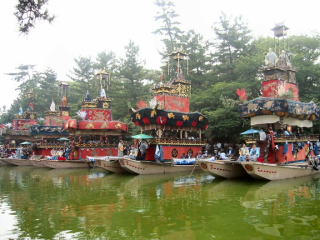 |
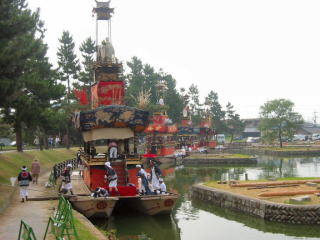 |
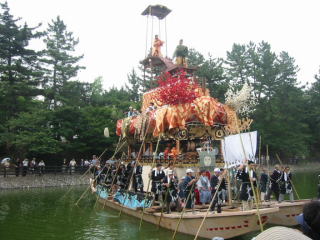 |
| Concentration click a picture to enlarge |
Standby | Start |
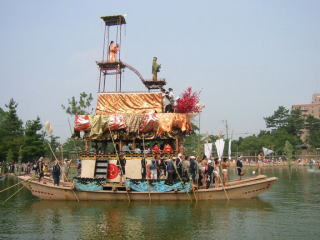 |
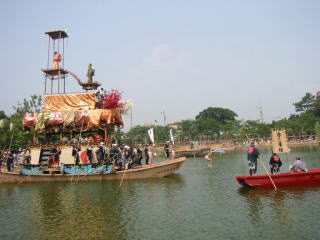 |
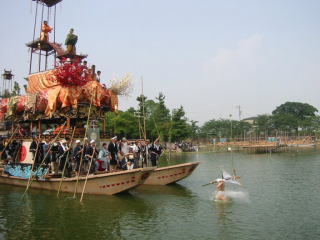 |
| Get ready 10 Hokomochi, who fill the role of carring pikes, standby on the boat named Ichiesha which offerd by Saya Cho (Saya Town) |
Jump ! They jump into the water with their pikes one after another |
Dedicate the pikes to the gods After they coross the river, they pray at Otabisho, and then visit Tsushima Shrine. |
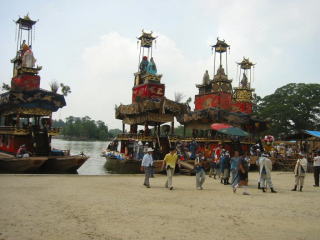 |
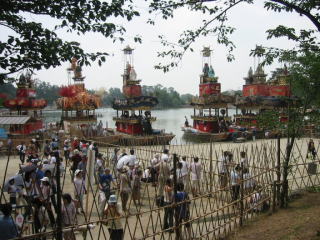 |
| Chigo, kagura bands, crew and participants get off the boats. After they join the shinto ceremony at the Otabisho, they parade to Tsushima Shrine with mikoshi/portable shrine. |
Six boats wait for chigo/children infront of Otabisho |
Access
Get off at Tsushima Sta. on the Meitetsu Line.
Walk 15 minutes
Inquiries
0567-28-8051
![]()
![]()